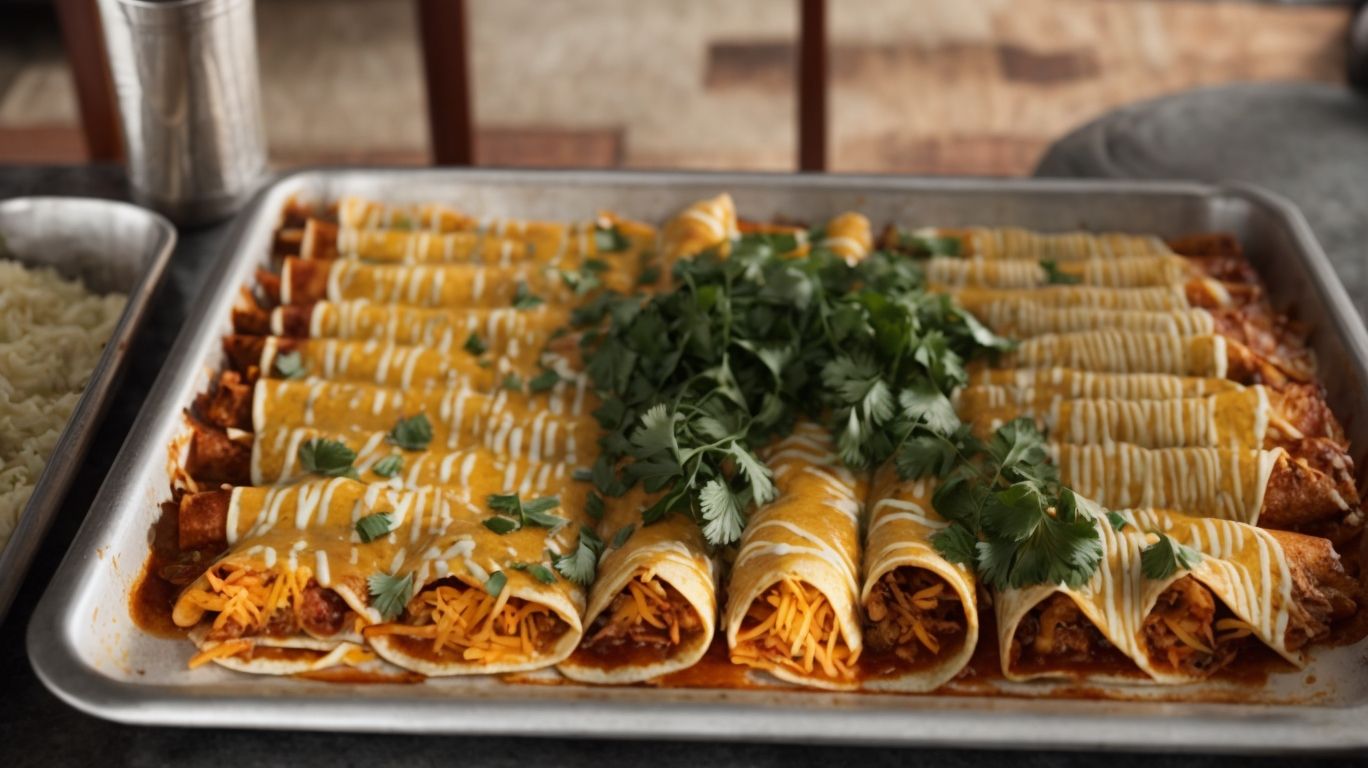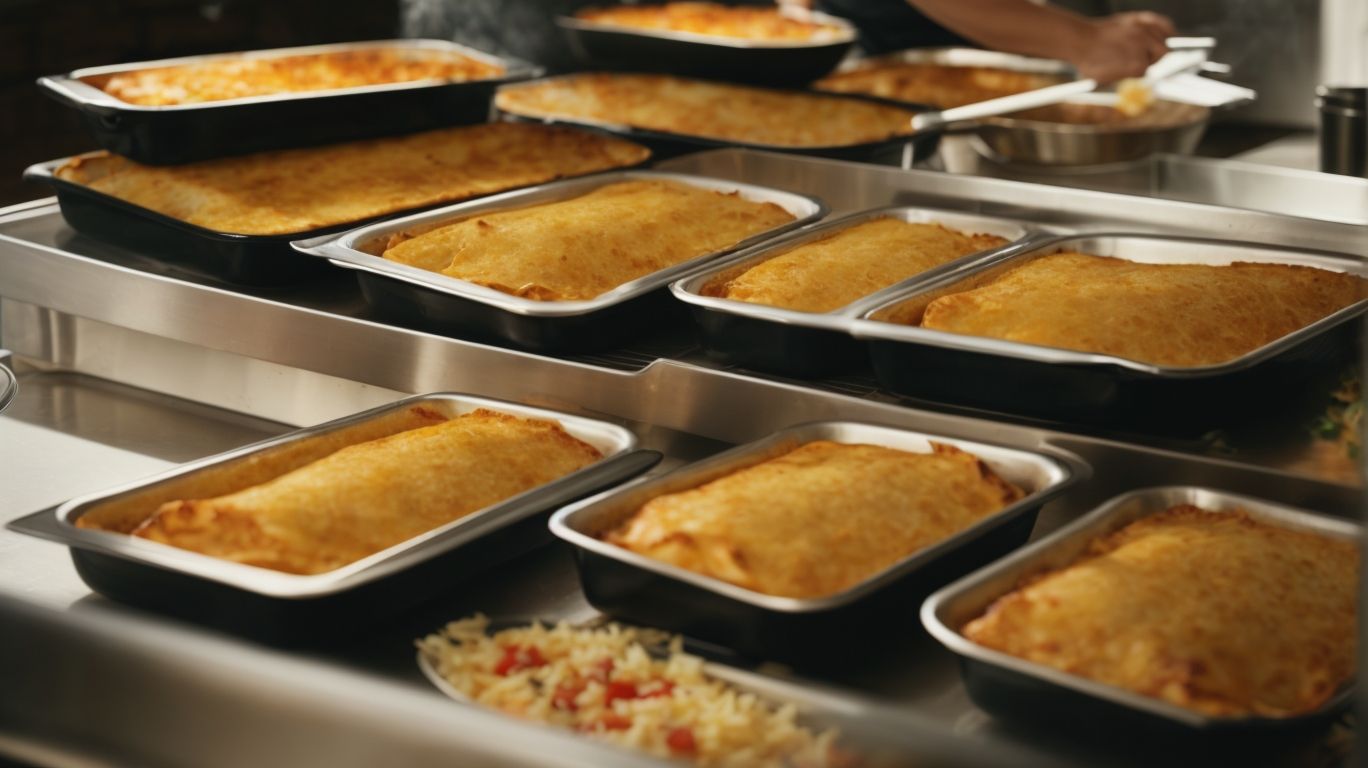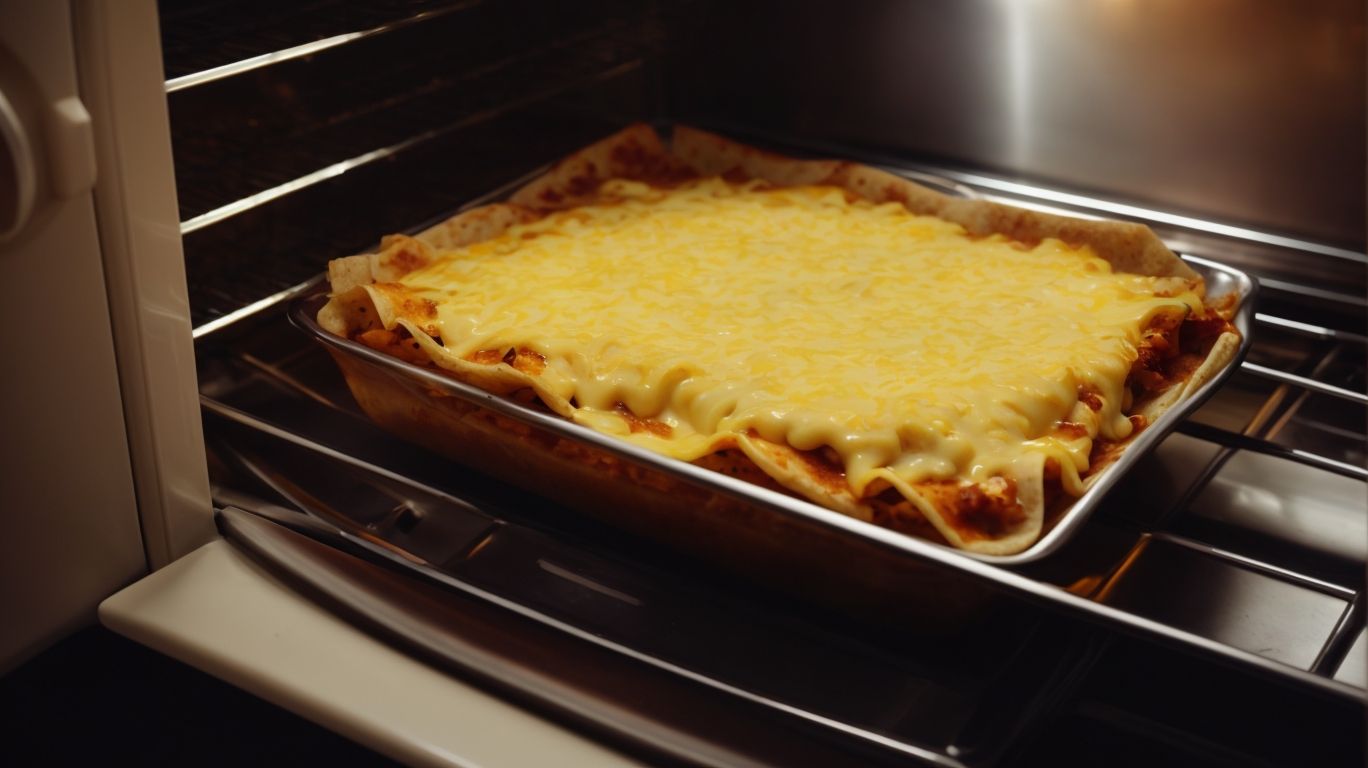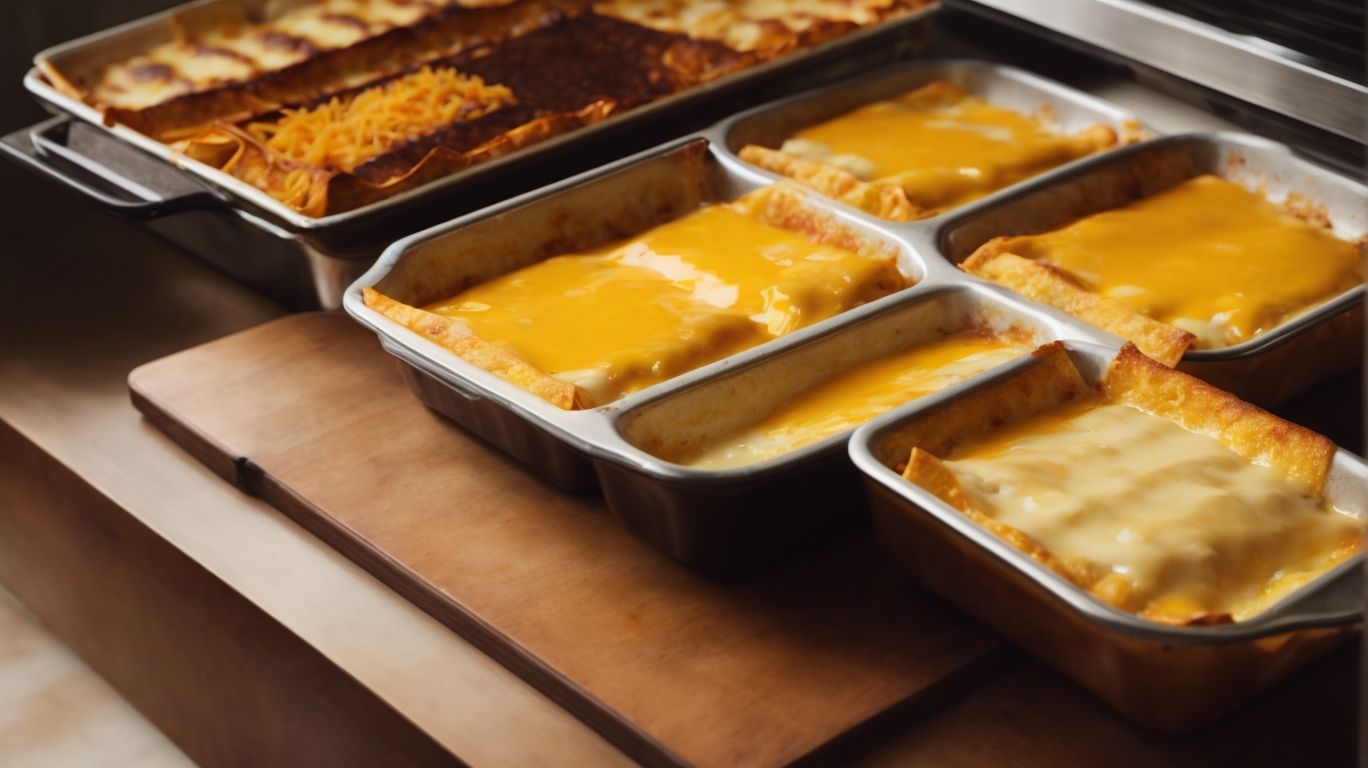How to Bake Enchiladas From Frozen?
Are you looking to enjoy delicious enchiladas at any time with minimal effort?
We will cover everything you need to know about preparing, freezing, baking, and reheating frozen enchiladas.
From the ingredients needed to the best baking dish and recommended baking time, we’ve got you covered.
Find expert tips on baking the perfect frozen enchiladas and enjoy a hassle-free culinary experience. Let’s dive in and discover the secrets to enjoying your favorite Mexican dish whenever the craving strikes!
Key Takeaways:
What Are Enchiladas?
Enchiladas are a popular Mexican dish consisting of rolled tortillas filled with a savory mixture, such as chicken, cheese, and other flavorful ingredients.
Enchiladas have a rich history originating in Mexico, with their roots dating back to the ancient Mayans and Aztecs who first combined tortillas with various fillings. Today, enchiladas come in various forms and fillings, showcasing the diversity and creativity of Mexican cuisine. From classic chicken and cheese to beef, bean, or seafood fillings, there is a wide range of options to suit different tastes.
They hold cultural significance in Mexican households and are often enjoyed during festive occasions and family gatherings. In Mexican cuisine, sour cream is a common accompaniment to enchiladas, adding a creamy and tangy element that complements the flavors of the dish.
What Are the Ingredients for Enchiladas?
The essential ingredients for making delicious enchiladas include tender chicken, soft tortillas, melting cheese, and creamy sour cream, all combined to create a mouthwatering culinary experience.
Regarding tender chicken, opting for boneless, skinless chicken breasts or thighs is ideal as they cook quickly and absorb the flavors of the enchilada sauce effortlessly. Soft tortillas, traditionally corn or flour, act as the vessel that holds all the savory goodness together. Make sure the tortillas are pliable to prevent tearing while rolling. Melting cheese, such as monterey jack or cheddar, adds a gooey, savory element that binds the filling together.
As for creamy sour cream, it serves as a cooling element to balance the spiciness of the enchiladas. You can choose full-fat or reduced-fat sour cream based on your preference. Don’t be afraid to experiment with different cheese blends or protein choices like beef or beans to personalize your enchiladas to suit your taste.
How to Prepare Enchiladas for Freezing?

Credits: Poormet.Com – Elijah Adams
Preparing enchiladas for freezing involves assembling the dish according to the recipe instructions and ensuring it is properly sealed and labeled for storage in the freezer.
When assembling enchiladas for freezing, begin by laying out your tortillas and filling ingredients, such as seasoned meats, beans, cheese, and sauces. Spoon a generous amount of the filling into each tortilla, being careful not to overfill, then tightly roll them up and place them seam-side down in your freezer-safe container.
- Ensure that the enchiladas are placed snugly in the container to prevent shifting during freezing.
- Before sealing the container, you may want to add a layer of sauce or cheese on top for extra moisture and flavor.
- Label the container with the date of preparation and cooking instructions for easy reference.
How to Properly Freeze Enchiladas?

Credits: Poormet.Com – Douglas Ramirez
To properly freeze enchiladas, use aluminum pans or freezer-safe containers to maintain the dish’s shape and protect it from freezer burn, ensuring optimal freshness upon reheating.
Aluminum pans are a convenient option as they can go from freezer to oven, simplifying the reheating process without needing to transfer the food. Alternatively, freezer-safe containers help prevent leakage and are ideal for enchiladas with sauces or gravies.
When freezing enchiladas, it’s crucial to freeze them as soon as they have cooled down to maintain their texture. Avoid stacking enchiladas on top of each other in the freezer; instead, freeze them in a single layer to prevent sticking and ensure even freezing.
How to Bake Frozen Enchiladas?
Baking frozen enchiladas is a simple process that involves preheating the oven, placing the dish inside, and baking until bubbly and golden brown, ready to serve and enjoy.
When preparing to bake frozen enchiladas, it’s crucial to preheat the oven to 375°F to ensure even cooking. Once the oven reaches the desired temperature, remove the enchiladas from the freezer packaging and place them in a baking dish. Bake the enchiladas in the oven for approximately 25-30 minutes until the edges are crispy and the cheese is melted.
For optimal serving, allow the enchiladas to rest for a few minutes after baking to set before serving. Garnish with fresh cilantro, sliced jalapeños, and a dollop of sour cream for a delightful finishing touch. These frozen enchiladas make a convenient and delicious meal that can be served with a side of Mexican rice and a refreshing avocado salad.
What Is the Best Baking Dish for Frozen Enchiladas?
Choosing the best baking dish for frozen enchiladas depends on personal preference and convenience, with options ranging from traditional baking pans to using a crockpot for a slow-cooked alternative.
Traditional baking pans, such as glass or metal casserole dishes, are popular choices for baking enchiladas in the oven. The glass pans allow you to monitor the browning of the dish, while metal pans conduct heat efficiently. On the other hand, a crockpot offers a hands-off approach, ideal for busy days when you want to set it and forget it. Choosing the right oven-safe baking pan ensures even cooking and easy cleanup, while the crockpot method yields tender, flavorful results with minimal effort.
What Is the Recommended Baking Time for Frozen Enchiladas?
The recommended baking time for frozen enchiladas typically ranges from 30 to 45 minutes in a preheated oven, ensuring thorough heating and a deliciously bubbly finish.
It’s essential to note that baking times can vary depending on the type and size of your oven. For smaller ovens, you may need to check the enchiladas around the 30-minute mark to ensure they are not overdone.
On the contrary, larger ovens might require closer to the 45-minute timeframe for the perfect melt-in-your-mouth enchiladas.
Remember, the key is to achieve a golden-brown crust on top while making sure the filling is thoroughly heated.
How to Check if Frozen Enchiladas Are Fully Cooked?
To confirm that frozen enchiladas are fully cooked, insert a knife into the center and check for piping hot temperatures throughout, ensuring that all layers are heated evenly.
Another method for verifying the doneness of frozen enchiladas is to visually inspect the top layer for a golden-brown hue, signifying that the dish has been properly baked. Using a food thermometer to check the internal temperature is a foolproof way to ensure that the enchiladas have reached a safe cooking temperature of at least 165°F. This step is crucial for guaranteeing that the filling is heated thoroughly and ready to be enjoyed.
How to Reheat Frozen Enchiladas?

Credits: Poormet.Com – Joseph Scott
Reheating frozen enchiladas can be done effectively using either an oven for a crispy finish or a microwave for quick and convenient heating, ensuring a delicious meal in no time.
When opting for the oven method, preheat it to 350°F (175°C) and cover the enchiladas loosely with foil to prevent excessive drying while allowing the cheese to melt beautifully.
Alternatively, the microwave method offers speed and efficiency; simply place the enchiladas on a microwave-safe plate, cover with a damp paper towel to retain moisture, and heat in intervals, stirring between each, for evenly heated leftovers.
What Is the Best Method for Reheating Frozen Enchiladas?
The best method for reheating frozen enchiladas depends on personal preference, with options including baking in the oven for a crispy texture or using a microwave for quick and convenient heating.
When reheating frozen enchiladas in the oven, the slow heat distribution ensures that the filling heats up evenly, creating a satisfying contrast between the warm, gooey center and the crispy edges. This method is perfect for those who appreciate the extra time it takes to achieve that perfect texture.
On the other hand, using a microwave for reheating offers the advantage of speed, making it ideal for busy days when you crave a delicious meal without the lengthy wait. While the microwave may not provide the same level of crispiness as the oven, it excels in efficiency, getting your frozen enchiladas ready to enjoy in mere minutes.
How to Avoid Overcooking Frozen Enchiladas?
To prevent overcooking frozen enchiladas, monitor the baking process closely and adjust the cooking time as needed, ensuring that the dish remains flavorful and not dried out.
One crucial tip is to use clear visual cues to determine when the enchiladas are perfectly baked. Look for the edges to be slightly crispy and golden brown, indicating that the dish is heated through. Cover the enchiladas with foil while baking to retain moisture and prevent the top layer from drying out.
What Are Some Tips for Baking Perfect Frozen Enchiladas?
Achieving perfect frozen enchiladas involves layering the components strategically, ensuring even distribution of ingredients, and adjusting baking times to achieve a golden, bubbling finish.
When layering your enchiladas, start with a thin layer of sauce at the bottom to prevent sticking and add flavor. Then, alternate between layers of tortillas, fillings, and cheese, repeating until you reach the top. Make sure to spread each ingredient evenly to create a harmonious blend of flavors.
Placing certain ingredients strategically, such as placing cheese on top to get beautifully melted, golden-brown perfection, can elevate the texture and taste of your enchiladas. Ingredients like onions, peppers, and meat can be strategically placed for optimal cooking and flavor infusion.
Conclusion: Enjoy Your Delicious Frozen Enchiladas!

Credits: Poormet.Com – Roy Lewis
Frozen enchiladas offer a convenient and delicious meal option that can be easily prepared, baked, and served with minimal effort, ensuring a satisfying dining experience for any occasion.
One of the key advantages of opting for frozen enchiladas is the time-saving aspect they bring to busy individuals. You can simply pop them in the oven without the need for chopping, sautéing, or any extensive preparation. This makes them perfect for hectic weeknights when you crave a homemade meal without the laborious cooking process.
The flavor profile of frozen enchiladas is surprisingly authentic, with the harmonious blend of spices, cheese, and tender protein infusing each bite with a burst of Mexican-inspired goodness. Whether you are a fan of mild or spicy dishes, frozen enchiladas cater to a wide range of taste preferences, making them a crowd-pleaser for gatherings or cozy nights in.
Once the enchiladas are hot and bubbly, ready to serve, their tantalizing aroma will fill your kitchen, creating an inviting ambiance that heightens the anticipation of digging into this comforting dish. With a side of fresh guacamole, salsa, or a crisp salad, these enchiladas can transform an ordinary meal into a fiesta, bringing joy to your taste buds.
Frequently Asked Questions
Can you bake enchiladas from frozen?
Yes, you can bake enchiladas straight from frozen. This is a great time-saving option for busy days or when you want to meal prep ahead of time.
What temperature should I bake frozen enchiladas at?
For best results, bake frozen enchiladas at 350 degrees Fahrenheit. This allows the enchiladas to cook thoroughly without burning the edges.
How long does it take to bake frozen enchiladas?
On average, frozen enchiladas take about 45-50 minutes to bake. However, this may vary depending on your oven and the thickness of your enchiladas. Be sure to check for doneness before removing them from the oven.
Do I need to thaw frozen enchiladas before baking?
No, there’s no need to thaw frozen enchiladas before baking. In fact, baking them straight from frozen helps retain their shape and prevents them from becoming mushy.
Do I need to cover frozen enchiladas while baking?
It’s recommended to cover frozen enchiladas with foil while baking. This helps trap the heat and moisture, ensuring that the enchiladas cook evenly without becoming too dry.
How can I tell if my frozen enchiladas are fully cooked?
You can tell if your frozen enchiladas are fully cooked by inserting a knife into the center of the enchilada. If the knife comes out clean and hot, the enchiladas are ready to be served. Alternatively, you can use a food thermometer to check that the internal temperature has reached at least 165 degrees Fahrenheit.

